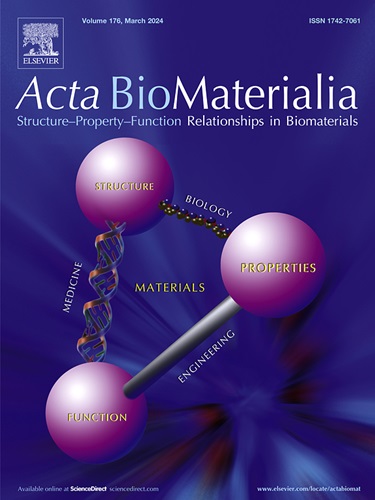Sequential release of vascular endothelial growth factor and platelet-derived growth factor at the appropriate time for improved angiogenesis
IF 9.4
1区 医学
Q1 ENGINEERING, BIOMEDICAL
引用次数: 0
Abstract
Sequential release of vascular endothelial growth factor (VEGF) and platelet-derived growth factor (PDGF) was proposed to enhance therapeutic angiogenesis, however, it remains a challenge to accomplish distinct sequential release of the two proteins. More importantly, the appropriate timing of PDGF release remains an open question. Herein to solve these problems, a new time-controlled release system was designed in which tannic acid/Pluronic F127 (TA/F127) layer-by-layer (LBL) films were used as erodible coatings. The hydrogen-bonded TA/F127 films disintegrate in water at a constant rate. Therefore this system can not only achieve distinct sequential release of two proteins, but can finely control the lag time of the second protein by the TA/F127 coating thickness. In this way drug carriers for sequential release of VEGF and PDGF were prepared. Their angiogenic effects were evaluated using a mouse model of lower limb ischemia. Improved therapeutic efficiency was observed when VEGF and PDGF were sequentially released. More importantly, it was observed that the therapeutic efficiency first increased with increasing TA/F127 film thickness, reached a maximum, and then dropped with further increased TA/F127 film thickness. The results demonstrated that it is important to release PDGF at the appropriate time point to further improve angiogenesis. For the first time, the appropriate timing for PDGF application was determined to be 5–7 days after the application of VEGF.
Statement of Significance
It remains a challenge to accomplish distinct sequential release of VEGF and PDGF to enhance therapeutic angiogenesis. The appropriate timing for PDGF release is also an open question. In this study, a new time-controlled release system using a TA/F127 layer-by-layer film as an erodible coating was designed. Not only can distinct sequential release of VEGF and PDGF be achieved, but the lag time of PDGF release can also be finely controlled by the coating thickness. In this way, the appropriate timing for PDGF application was successfully determined.

血管内皮生长因子和血小板衍生生长因子在适当时间的顺序释放促进血管生成。
血管内皮生长因子(VEGF)和血小板衍生生长因子(PDGF)的顺序释放被提出用于增强治疗性血管生成,然而,实现这两种蛋白的不同顺序释放仍然是一个挑战。更重要的是,PDGF释放的合适时机仍然是一个悬而未决的问题。为了解决这些问题,设计了一种以单宁酸/Pluronic F127 (TA/F127)层析膜(LBL)为可蚀涂层的新型控释体系。氢键TA/F127薄膜在水中以恒定速率崩解。因此,该系统不仅可以实现两种蛋白的明显顺序释放,而且可以通过TA/F127涂层厚度精细地控制第二种蛋白的滞后时间。通过这种方法制备了顺序释放VEGF和PDGF的药物载体。用小鼠下肢缺血模型评价其血管生成作用。当VEGF和PDGF相继释放时,治疗效果明显改善。更重要的是,观察到治疗效率首先随着TA/F127膜厚度的增加而增加,达到最大值,然后随着TA/F127膜厚度的进一步增加而下降。结果表明,在适当的时间点释放PDGF对进一步促进血管生成至关重要。首次确定PDGF应用的合适时机为VEGF应用后5-7天。意义声明:实现不同顺序的VEGF和PDGF释放以增强治疗性血管生成仍然是一个挑战。PDGF释放的适当时机也是一个悬而未决的问题。在这项研究中,设计了一种新的时间控制释放系统,使用TA/F127层膜作为可蚀涂层。不仅可以实现VEGF和PDGF的明显顺序释放,而且PDGF的释放滞后时间也可以通过涂层厚度来精细控制。通过这种方式,成功地确定了PDGF应用的适当时机。
本文章由计算机程序翻译,如有差异,请以英文原文为准。
求助全文
约1分钟内获得全文
求助全文
来源期刊

Acta Biomaterialia
工程技术-材料科学:生物材料
CiteScore
16.80
自引率
3.10%
发文量
776
审稿时长
30 days
期刊介绍:
Acta Biomaterialia is a monthly peer-reviewed scientific journal published by Elsevier. The journal was established in January 2005. The editor-in-chief is W.R. Wagner (University of Pittsburgh). The journal covers research in biomaterials science, including the interrelationship of biomaterial structure and function from macroscale to nanoscale. Topical coverage includes biomedical and biocompatible materials.
 求助内容:
求助内容: 应助结果提醒方式:
应助结果提醒方式:


